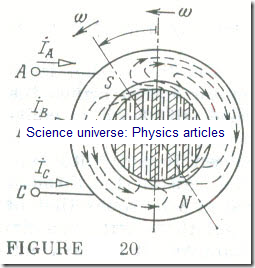Fractional-Horsepower Synchronous Motors
The property of synchronous motors to run at constant speed despite variations in the load torque is achieved by connecting a d.c. source to the rotor winding via sliding contacts. Instead of a d.c. excited electromagnet, fractional-hp synchronous motor use a permanent magnet fabricated from a magnetically hard material and mounted on the rotor shaft.
With this arrangement there is no need for an auxiliary d.c. source, and the motor is usually started by connecting its stator phase winding directly to the supply line. The pole pairs of the permanent magnet carry the bars of a short-circuited (damper) winding intended to produce the starting torque by induction action.
There is a further variety of fractional-hp synchronous motor known a reluctance synchronous motors. Their distinction is that the rotor has the property of magnetic anisotropy which means that its reluctance is different in different directions. A sectional view of a two-pole anisotropic rotor is shown in Fig 20. As is seen, the rotor is an assembly of electrical-sheet steel laminations interleaved with a layer of aluminium (the shaded areas). At synchronous speed, the blocks of rotor laminations are magnetized in the easy direction, and this determines the magnetic flux pattern set up by the stator currents. With load applied to the motor shaft, the magnetic flux due to the stator currents is bent, and this gives rise to a driving torque which balances the load torque.
A limitation common to all fractional-hp synchronous motors is the fact that there is no way of controlling their reactive power and the margin of stability.

